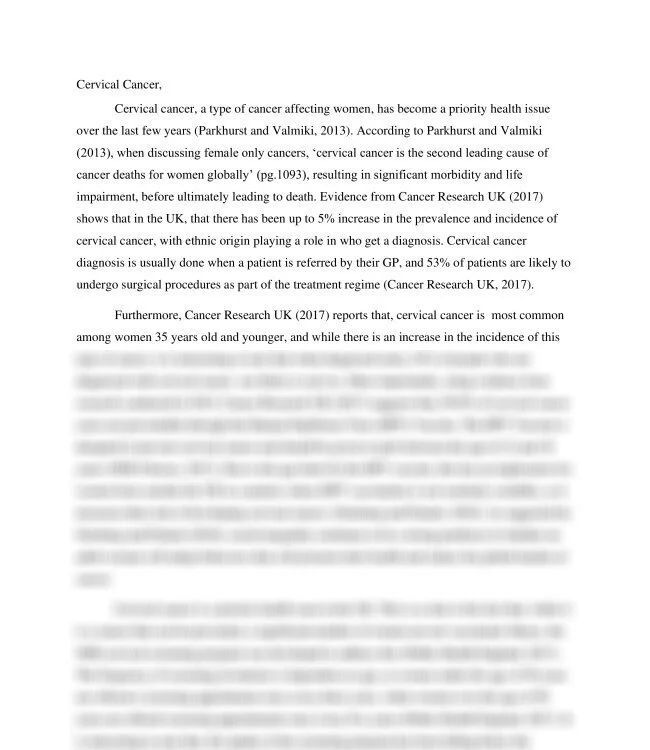Cervical Cancer Cervical cancer, a type of cancer affecting women, has become a priority health issue over the last few years (Parkhurst and Valmiki, 2019). According to Parkhurst and Valmiki (2019),
Cervical Cancer Cervical cancer, a type of cancer affecting women, has become a priority health issue over the last few years (Parkhurst and Valmiki, 2019). According to Parkhurst and Valmiki (2019),
(2007) (2010), (2014) (2015) (2015), (2017) (2018) (2018), (2019) (2019), (Cancer (Crosbie (Ginsburg (HPV) (Jo's (Marlow (NHS (Parkhurst (Public (pg. (pg.1093), (pg.2). 12 16 18 185. 19,332 2015) 2015). 2015, 2017 2017) 2017), 2017). 2018), 2018). 2018]. 2019). 25-01 27-06 3(1), 35 49 5% 50 53% 63% 66 7(3), 833) 9,000 99.8% : A., According Although As Atack, Available B., Balata, Balls, Balls-Berry Balls-Berry, Barber, Barbershop Bayliss-Brideaux, Be Beyond Black Booton, By C. C., Campaigns Cancer Cancer, Cervical Cervix Check’ Choices, Colligan, Crosbie Crosbie, D. D., Dacy, Due Duerden, E. E., Eaglesfield, Edmunds, Education Edwards, Effect Eggo, Elton, England, Ethnic Evidence Evison, Existing Factors Ferguson Firstly, Foster, Furthermore, G., GP GP, GPs Ginsburg Ginsburg, Grapevine”: Greaves, Groups H. H., HPV Hayler, Health Health, Hektoen Hence, Higgins, Howells, Human I., Implementing In Information. Irion, It J. J., Jo's Johnson Johnson, Jo’s K., Karunaratne, Kelly, King, L. L., Lafferty, Lancet Linnan Locations Louie, M., Manchester. Manson, Many Marlow Mellor, Miller, Minority More Myerscough, N. NHS Newton, O. O’Leary, P. P., Papilloma Parkhurst Paskett Paskett, Pearson, Pickford, Public R. R., Reference: Releford Research Roadshow S., Savvy Sawyer, Screaton, Screening Sharman, Simmons, Since Smith, Soldan, Source Strategic T., Taylor, The There This Thorax. Threlfall, Thus, Tonge, Trust, Trust. UK UK, UK. V., Vaccine Vaccine. Valmiki Valmiki, Virus Visiting W. Waller, Walsham, Watts, While Whittaker, With Yarnell, Z., [Accessed [Online]. a abnormal about across activity activity, addition, additional address addressed administered. adopt adult affecting after age age, aim al. al., all also among an and anxiety appointment appointments appointments, appointments. approach approach, approaches are areas as asymptomatic asymptomatic. at at: attend attended available, avenues average awareness awareness, barbershops, barrier barriers barriers, baseline basic be beauty become been before behaviors being belief below bespoke between born burden by campaign campaign. can cancer cancer, cancer. cancer: cancers, cases cause causes cervical charity, churches, cities commitments commitments’ common communities communities, communities. community-based conducted conducted, confirm confirmation. conflicting consideration contends continues conversations, countries customers customers. days. death. deaths decline delivered. dependent deprived designed developed developing development diagnosed diagnosis diagnosis, diagnosis. did difficulty discuss discussed, discussing disparities distribution do done due e8-e9. early, educate education either element enable engage engaged engaging ensure ensuring entail especially et ethnic ever every evidence existing expected fact factors falling false-positive female few finding first fits five focused for four frequency from further generate get girls give given giving global globally, globally’ groups groups. has have having health health, healthcare highlight highlighted highlighted, highlights hree http://hektoeninternational.org/index.php?option=com_content&view=article&id=1871. http://www.cancerresearchuk.org/health-professional/cancer-statistics/statistics-by-cancer-type/cervical-cancer#heading-Two https://www.jostrust.org.uk/sites/default/files/be_cervix_savvy_roadshow_executive_summary_final.pdf. humanities, identified impairment, implication importance important importantly, improve in inactive inactivity, incidence include incorporating increase increases indicated indication inequality information informed interesting international intervention interventions into invitations is issue issues issues. it journal knowledge lack language last lasting lauded, leading less lessons life likelihood likely limit literacy literature local longer low-risk lung made many materials materials, may medical meet meet. might migrate minority misconception misinformation mitigating modelling morbidity more mortality mosques most national need needs new normally not note number of offer offered old on on-site on-the once one only option or order origin other others outside over owners owners, parlor parlours part patient patients people people’s perceived periods pilot playing plays population populations populations, population’ possible potential predictor present presented prevalence prevent preventable prevented, preventing prevention. priority proactive proactively procedures professionals professionals, program programmed. promote provided providing racial raise raising rather reasons received reduce referred regarding regime relevant report report, report. reported, reports required research resources respect respects result result, resulting results risk roadshow. roadshows role routinely safe salon salon. salons salons, screened screened. screening screening, screening. screening: second self-refer service services serving sexual sexually should shown shows significant signpost signposting since site six smear social some space specific spot staff steady strategies strategy strong study stylists success such suggested suggested. suggests surgical survive. symptoms synthesis tCervical take taking talking targeting test test. tests than that that, the their them then there they this three through thus, to to, topical treatment two type ultimately under undergo understand understanding unnecessary up uptake uptake, using usually utilization utilization, vaccinated. vaccination vaccine vaccine, vaccine. various visit visited vulnerable wait was well were when where whether which while who why will with within without woman women women, women. women’s working would year years years, younger, ‘Lung ‘cervical ‘culturally ‘low “Heard
Cervical Cancer,
Cervical cancer, a type of cancer affecting women, has become a priority health issue over the last few years (Parkhurst and Valmiki, 2019). According to Parkhurst and Valmiki (2019), when discussing female only cancers, ‘cervical cancer is the second leading cause of cancer deaths for women globally’ (pg.1093), resulting in significant morbidity and life impairment, before ultimately leading to death. Evidence from Cancer Research UK (2019) shows that in the UK, that there has been up to 5% increase in the prevalence and incidence of cervical cancer, with ethnic origin playing a role in who get a diagnosis. Cervical cancer
